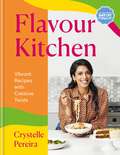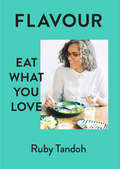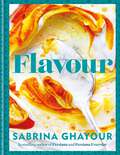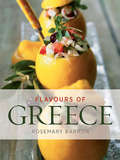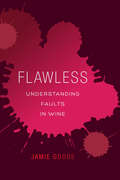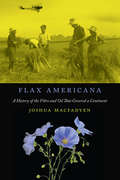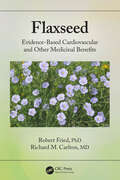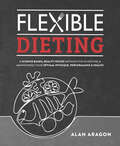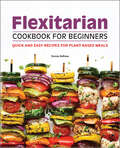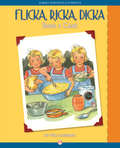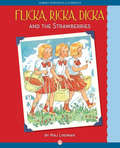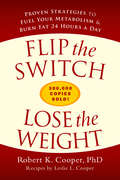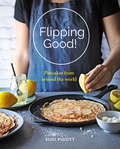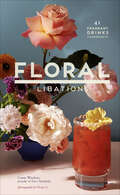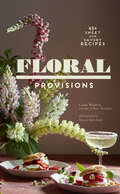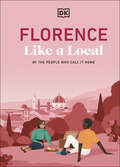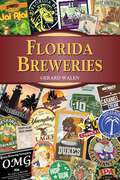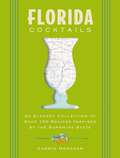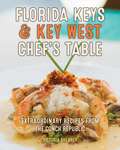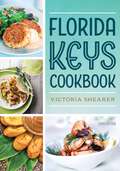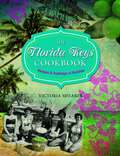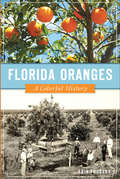- Table View
- List View
Flavour Kitchen: Vibrant Recipes with Creative Twists
by Crystelle PereiraTasty, enticing, and bursting with flavour, Crystelle's recipes make cooking and baking with the most vibrant and exciting flavours easy.Divided into two halves - savoury and sweet - the book showcases the baking that took Crystelle to the final of The Great British Bake Off, as well as her flair for creative savoury dishes. Drawing inspiration from around the world, there are 75 flavour-packed recipes here for every occasion, from zingy curries, mouth-watering pastas and zesty salads to scrumptious cakes, pull-apart breads and indulgent brownies. Featuring a handy guide to Crystelle's hero ingredients and star seasonings - all of which feature in multiple recipes - it couldn't be easier to raise your flavour game.
Flavour: Eat What You Love
by Ruby TandohOver 170 recipes – sweet and savoury – for every day, every budget, every taste, in a cookbook that puts your appetite first from the Sunday Times top ten bestselling author of Eat Up.Organised by ingredient, Flavour helps you to follow your cravings, or whatever you have in the fridge, to a recipe. Creative, approachable and inspiring, this is cooking that, while focusing on practicality and affordability, leaves you free to go wherever your appetite takes you. It is a celebration of the joy of cooking and eating. Ruby encourages us to look at the best ways to cook each ingredient; when it’s in season, and which flavours pair well with it. With this thoughtful approach, every ingredient has space to shine; including store cupboard staples. These are recipes that feel good to make, eat and share, and each plate of food is assembled with care and balance. Including Hot and Sour Lentil Soup, Ghanaian Groundnut Chicken Stew, Glazed Blueberry Fritter Doughnuts, Mystic Pizza and Carrot and Feta Bites with Lime Yoghurt, this is a cookbook that focuses above all on flavour and freedom – to eat what you love.
Flavour: Over 100 fabulously flavourful recipes with a Middle-Eastern twist
by Sabrina Ghayour'I am grateful to add Flavour, quite simply a gorgeous book, to my Sabrina Shelf. As ever, deliciousness abounds...' - Nigella Lawson'Sabrina Ghayour has a knack for colourful, intensely flavoured, no-fuss recipes ... Perfect for relaxed family suppers' - Daily Mail'Sabrina Ghayour's appeal is in offering simple Persian and Middle Eastern-inspired recipes that are fuss-free and burst with flavour... this new book has that appeal in spades - Delicious MagazineThe new collection of simple, delicious, crowd-pleasing recipes from the bestselling Middle-Eastern chef.Enjoy over 100 fabulously flavourful recipes with a Middle-Eastern twist - perfect for family, friends and every occasion. CONTENTS INCLUDE:SaladsChicken shawarma salad; Halloumi, blood orange & pistachio rocket salad; Spice roasted butternut & black rice saladLittle bites & savoury treatsCurried cheese & potato puffs; Tamarind chicken wings; My sweet, salty & sublime BHTMeat, poultry, fish & seafoodHerb koftas with warm yogurt sauce & spiced mint butter; Ras el Hanout & orange lamb cutlet platter; Pan-fried salmon with barberry butterVegetables & pulsesSmoked aubergine with lime & maple dressing; Charred broccoli with lemons, chillies & yogurt; Mama ghanoushPasta, noodles & grainsHarissa, tahini & lamb spaghetti; Nut butter noodles; samosa pastaSweetFeta, basil & strawberry cheesecake cups; Lime, coconut & cardamom loaf cake; Pistachio & chocolate dream cakePraise for Sabrina Ghayour:'Sabrina Ghayour's Middle-Eastern plus food is all flavour, no fuss - and makes me very, very happy' - Nigella Lawson'I don't think she could write a dull recipe if she tried. Every one an elegantly spiced delight.' - Tom Parker Bowles'The golden girl of Persian cookery' - Observer
Flavour: Over 100 fabulously flavourful recipes with a Middle-Eastern twist
by Sabrina Ghayour'Quite simply a gorgeous book... As ever, deliciousness abounds.' - Nigella Lawson'Sabrina Ghayour has a knack for colourful, intensely flavoured, no-fuss recipes ... Perfect for relaxed family suppers' - Daily Mail'Simple Persian and Middle Eastern-inspired recipes that are fuss-free and burst with flavour' - Delicious MagazineThe brand new collection of simple, delicious, crowd-pleasing recipes from the bestselling Middle-Eastern chef.Enjoy over 100 fabulously flavourful recipes with a Middle-Eastern twist - perfect for family, friends and every occasion. CONTENTS INCLUDE:SaladsChicken shawarma salad; Halloumi, blood orange & pistachio rocket salad; Spice roasted butternut & black rice saladLittle bites & savoury treatsCurried cheese & potato puffs; Tamarind chicken wings; My sweet, salty & sublime BHTMeat, poultry, fish & seafoodHerb koftas with warm yogurt sauce & spiced mint butter; Ras el Hanout & orange lamb cutlet platter; Pan-fried salmon with barberry butterVegetables & pulsesSmoked aubergine with lime & maple dressing; Charred broccoli with lemons, chillies & yogurt; Mama ghanoushPasta, noodles & grainsHarissa, tahini & lamb spaghetti; Nut butter noodles; samosa pastaSweetFeta, basil & strawberry cheesecake cups; Lime, coconut & cardamom loaf cake; Pistachio & chocolate dream cakePraise for Sabrina Ghayour:'Sabrina Ghayour's Middle-Eastern plus food is all flavour, no fuss - and makes me very, very happy' - Nigella Lawson'I don't think she could write a dull recipe if she tried. Every one an elegantly spiced delight.' - Tom Parker Bowles'The golden girl of Persian cookery' - Observer
Flavours of Greece
by Rosemary BarronRosemary Barrons Flavours of Greece was first published in 1991 and has never gone out of print. It is now generally regarded as the most authentic and authoritative collection of Greek recipes. It was chosen as an Editor's Choice in The New York Times in the year of its publication and it is the only recipe book listed in The Rough Guide to Greece and The Rough Guide to the Greek Islands. Rosemary is about to open an international cookery on Kythira teaching traditional Greek cuisine and to coincide with this event Grub Street is issuing a new full color edition of this wonderful book. In this celebration of Greek food Rosemary provides over 250 regional and national specialties, from the olives, feta and seafood of mezes, to delicate lemon broths, hearty bean soups, grilled meats and fish, baked vegetables and pilafs, to fragrant, gooey honey pastries. Greek cooking offers seasonal food perfect for informal eating with family, friends and entertaining. In the 80s Rosemary owned a cooking school based in a 450 year-old village house on the island of Crete. This was the first of its kind in Greece, and described by Vogue magazine in 1982 as one of the best cooking schools in Europe. Her recent courses on Santorini, exploring the foods and flavors of Greek antiquity, have been described by Conde Nast Traveller as one of the top ten cookery courses in Europe. For nearly three decades, Rosemary has organized programs and presented lectures and workshops on culinary matters to a wide variety of audiences.
Flawless: Understanding Faults in Wine
by Jamie GoodeFlawless is the first book of its kind dedicated to exploring the main causes of faults in wine. From cork taint, to volatile acidity, to off-putting aromas and flavors, all wine connoisseurs have encountered unappealing qualities in a disappointing bottle. But are all faults truly bad? Are some even desirable? Jamie Goode brings his authoritative voice to the table once again to demystify the science behind what causes a good bottle to go bad. By exposing the root causes of faults in wine, Flawless challenges us to rethink our assumptions about how wine should taste and how we can understand beauty in a glass.
Flax Americana: A History of the Fibre and Oil That Covered a Continent (McGill-Queen's Rural, Wildland, and Resource Studies #10)
by Joshua MacFadyenFarmers feed cities, but starting in the nineteenth century they painted them too. Flax from Canada and the northern United States produced fibre for textiles and linseed oil for paint – critical commodities in a century when wars were fought over fibre and when increased urbanization demanded expanded paint markets. Flax Americana re-examines the changing relationships between farmers, urban consumers, and the land through a narrative of Canada’s first and most important industrial crop. <p><p> Initially a specialty crop grown by Mennonites and other communities on contracts for small-town mill complexes, flax became big business in the late nineteenth century as multinational linseed oil companies quickly displaced rural mills. Flax cultivation spread across the northern plains and prairies, particularly along the edges of dryland settlement, and then into similar ecosystems in South America’s Pampas. <p> Joshua MacFadyen’s detailed examination of archival records reveals the complexity of a global commodity and its impact on the eastern Great Lakes and northern Great Plains. He demonstrates how international networks of scientists, businesses, and regulators attempted to predict and control the crop’s frontier geography, how evolving consumer concerns about product quality and safety shaped the market and its regulations, and how the nature of each region encouraged some forms of business and limited others. <p> The northern flax industry emerged because of border-crossing communities. By following the plant across countries and over time Flax Americana sheds new light on the ways that commodities, frontiers, and industrial capitalism shaped the modern world.
Flaxseed: Evidence-based Cardiovascular and other Medicinal Benefits
by Robert Fried Richard CarltonPhysicians, scientists and savvy laypeople want reliable information on foods and supplements which might improve the outcome in chronic diseases that otherwise shorten our lives. These health conditions include type 2 diabetes, heart attacks, high blood pressure, chronic kidney disease and others. Incorporating flaxseed into one's diet can greatly improve outcomes in various health conditions. Thousands of peer-reviewed articles have been published documenting the clinical efficacy of flaxseed as a whole or its individual components and reveal the mechanisms by which those various components work. Flaxseed: Evidence-Based Cardiovascular and Other Medicinal Benefits is an encyclopedic and definitive text describing the health benefits of this humble plant. The book features exquisite detail on the three major components of the plant that are responsible for most of the documented benefits, those components being omega-3 fatty acids and two compounds that increase endothelial production of nitric oxide, those compounds being the amino acid L-arginine, and cyanogenic glycosides. Attention Readers: If you are not already familiar with the health benefits of omega-3 fatty acids and of the above-named nitric oxide donors, then this book opens a vast world of scientific discovery that one can immediately apply to improving health. This book calls attention to a wealth of journal articles providing practical information on consuming flaxseed and its overall health benefits. Enjoy!
Flexible Dieting: A Science-Based, Reality-Tested Method for Achieving and Maintaining Your Optima l Physique, Performance & Health
by Alan AragonThe last nutritional model you will ever need to achieve and maintain your optimal physique, peak performance, and robust health.Do you find yourself confused by the ever-changing diet landscape? Low-carb, keto, low-fat, Paleo, supplements you can&’t pronounce, and of course the fix-all magic bullet—it becomes a minefield of endless frustration with little or no sustainable results to show for it. In his new book Flexible Dieting: A Science-Based, Reality-Tested Method for Achieving & Maintaining Your Optimal Physique, Performance, and Health, Alan Aragon is here to put an end to the confusion and put you on a path to success. With over 25 years of experience as a nutrition researcher and educator, Alan reveals the biggest diet secret of all—no single diet is best for everyone. The key to success is finding a tailored program that meets your individual needs and helps you build lifelong habits to support your goals. Flexible Dieting is a research-based, field-tested approach to nutrition that focuses on macronutrient balance and proper food sourcing that will help you achieve your dietary and physical goals at your own pace. With this simple weight-loss plan, Alan shows you how to eat within your specific macronutrient targets, making weight loss achievable and sustainable while fostering a healthy relationship with food and offering more freedom in your food choices.
Flexitarian Cookbook for Beginners: Quick and Easy Recipes for Plant-Based Meals
by Donna DeRosaGo flexitarian with this starter guide to (mostly) plant-based eating This vegan version of the flexitarian diet is a healthy and delicious way to incorporate plant-based meals into your routine without giving up meat and dairy altogether. But if you're new to plant-based eating, getting started can feel overwhelming. The Flexitarian Cookbook for Beginners makes adjusting to this diet easy, with simple and delicious recipes that are ready to eat in a flash. What sets this flexitarian cookbook apart: Flex eating tips—Every one of these plant-based recipes includes easy suggestions for adding meat, fish, or dairy for those days when you're craving a little more variety, or feeding a non-flexitarian crowd. Convenient cooking techniques—From 5-ingredient recipes to one-pot meals and 30-minute prep times, these dishes are designed to cut down on time spent in the kitchen and at the grocery store. Guided meal plans—Ease into the flexitarian lifestyle with two sample meal plans that each detail everything you'll eat for a week, with clear instructions and complete shopping lists to ensure success. Get healthier and enjoy flavorful favorites with this entry point into the flexitarian diet for beginners.
Flicka, Ricka, Dicka Bake a Cake
by Maj LindmanSoon it will be Mother's birthday, and Flicka, Ricka, and Dicka can't think of what to give their mother. Aunt Betty shows them how to bake a cake by themselves. All is fine until the girls put the cake in the oven and go out to play. Will they remember the cake before it burns?
Flicka, Ricka, Dicka and the Strawberries
by Maj LindmanFlicka, Ricka, and Dicka are going wild-strawberry picking. Mother is going to pay them for every basket they gather. When they stop at a cottage along the way, they meet Mary, her baby brother, and Mary's mother. Mary and her family are very kind, but have patches on their clothes and no milk to drink. After the girls get home and help Mother make strawberry jam, they think of a special way to spend the money they have earned.
Flip the Switch, Lose the Weight: Proven Strategies to Fuel Your Metabolism and Burn Fat 24 Hours a Day
by Robert K. Cooper Leslie L. Cooper<p>Discover how easy it can be to drop those unwanted pounds by flipping the switch that revs up metabolism to maximize fat burning all day longCould losing weight really be as simple as flipping a switch? <p>Absolutely, says Dr. Robert Cooper, one of America's leading weight-loss researchers. The trouble with most popular diet-and-exercise programs is that they boot up the metabolic thermostat, or Meta-Stat (an area in the brain that regulates metabolism), for only short spurts. <p>The rest of the time the body is in fat-storing mode. But if our Meta-Stat stays on 24 hours a day, we burn fat constantly—and build energy as well. In Flip the Switch, Lose the Weight, Dr. Cooper reveals scientifically proven strategies that enable us to turn on our Meta-Stat and maintain optimum metabolism all day long. <p>This groundbreaking book:• provides an easy 20-minute exercise plan that gently works the body differently on successive days for maximum fat-burning, energy-generating effect <br>• allows you to customize your weight-loss program based on your goals and lifestyle preferences <br>• provides an exclusive "Success Map" for you to chart your progress <br>• includes complete meal plans and more than 100 recipes, all designed to fuel the Meta-Stat for maximum fat burning
Flipping Good
by Sudi PigottEveryone loves pancakes and with Flipping Good! you can make them a regular occurrence, with no need to wait for pancake day. Sudi has taken inspiration from countries all over the world to create a dynamic and intriguing collection of recipes such as Ricotta pancakes with Banana and Honeycomb Orange Butter; Buttermilk and Spelt Pancake Stack with Poached Blackberries; Potato Latkes with Sumac Fried Egg; Galettes de Sarrasin with Leeks and Merguez sausage; Okonomiyaki with Shredded Cabbage, Prawns and Tamarind Sauce; Banh Xeo Rice Flour Pancakes with Prawns, Shitake and Mangetout; Russian Buckwheat Blini with Smoked Salmon; Fluffy Coconut Flour Pancakes with Apricots and Maple Syrup; Kaiserschmarren with Plum Compote. Organised into chapters on Breakfast & Brunch, Snacks, Main Meals, and Teatime & Desserts you're sure to find something for every occasion.
Flipping Good: Sweet And Savory Recipes From Near And Far
by Sudi PigottEveryone loves pancakes and with Flipping Good! you can make them a regular occurrence, with no need to wait for pancake day. Sudi has taken inspiration from countries all over the world to create a dynamic and intriguing collection of recipes such as Ricotta pancakes with Banana and Honeycomb Orange Butter; Buttermilk and Spelt Pancake Stack with Poached Blackberries; Potato Latkes with Sumac Fried Egg; Galettes de Sarrasin with Leeks and Merguez sausage; Okonomiyaki with Shredded Cabbage, Prawns and Tamarind Sauce; Banh Xeo Rice Flour Pancakes with Prawns, Shitake and Mangetout; Russian Buckwheat Blini with Smoked Salmon; Fluffy Coconut Flour Pancakes with Apricots and Maple Syrup; Kaiserschmarren with Plum Compote. Organised into chapters on Breakfast & Brunch, Snacks, Main Meals, and Teatime & Desserts you're sure to find something for every occasion.
Floral Libations: 41 Fragrant Drinks + Ingredients
by Cassie WinslowExplore the unique flavors of flowers with these delicious (and decorative) drink recipes—with or without alcohol. Elegant, edible flowers are becoming more accessible every day—and they taste as good as they look. This curated collection of forty-one delightful recipes combines the playful creativity of fashion, the deliciousness of food, and the beauty of flowers in one gorgeous glass. Whether you're throwing a baby shower, hosting a Mother&’s Day brunch, celebrating a wedding, or simply entertaining guests, there&’s something for everyone, with or without alcohol, including: • Iced Lavender Café au Lait • Rose Petal Almond Milk • Dandelion Tea Cinnamon Cappuccino • Hibiscus Old Fashioned • Plum Rosewater Gin and Tonic • Orange Blossom Moscow Mule Learn how to create floral pantry item staples to create a scrumptious and sophisticated cocktail of your own, and embark on a new culinary adventure. This garden-party eye candy also includes practical tips on where to buy edible flowers, whether to choose fresh or dried flowers, how to grow edible flowers at home, and how to use florals in other recipes.
Floral Provisions: 45+ Sweet and Savory Recipes
by Cassie WinslowDiscover delicious treats made with edible flowers.Sweeten your everyday meals and treats with this whimsical cookbook where flowers take a starring role. Floral Provisions makes incorporating edible flowers into dishes and desserts an easy task—with gorgeous and delicious results. Perfect for brunches, picnics, afternoon snacks, or celebrations, recipes include:• Rose Petal French Toast• Raspberry Elderflower Scones• A Floral Cheese Board• Garden Party Layer CakeFeaturing lush photography; recipes for floral pantry staples, like Jasmine Sugar and Lavender Syrup; and tips for finding edible blooms, this cookbook is the ideal gift for anyone who loves flowers, cooking, delicious treats, or all of the above.PERFECT FOR MOTHER'S DAY, BABY SHOWERS, AND WEDDING SHOWERS: Sweet treats and flowers wrapped up in a light, lovely package make this an irresistible gift and the perfect accompaniment to Floral Libations.MORE FLORAL RECIPES TO LOVE: Readers already love the simple recipes and unique flavors of Floral Libations, and this book expands on that concept by offering a wide range of treats and sweets that incorporate rose, lavender, calendula, and more.MORE THAN JUST RECIPES: While the recipes are easy to make, the flavors are uniquely delicious. Plus, this book includes tips on using edible flowers, a guide to floral pantry staples to incorporate into everyday dishes, and information on choosing the best blooms to add to any dish.Perfect for:• Fans of flowers• Mother's Day shoppers• Garden enthusiasts and gardeners• Bakers who love a new idea• Home entertainers throwing a brunch, baby shower, wedding lunch, simple picnic, or any other kind of get-together with friends and family
Florence Like a Local: By the People Who Call It Home (Local Travel Guide)
by DK TravelKeen to explore a different side of Florence? Like a Local is the book for you.This isn’t your ordinary travel guide. Beyond the Renaissance treasures that define the city, you'll find hidden dive bars, community gardens and mini basement galleries hosting fashion events – and that’s where this book takes you. Turn the pages to discover:- The small businesses and community strongholds that add character to this vibrant city, recommended by true locals.- 6 themed walking tours dedicated to specific experiences such as street food and swimming pots.- A beautiful gift book for anyone seeking to explore Florence.- Helpful ‘what3word’ addresses, so you can pinpoint all the listed sights.Compiled by three proud locals, this stylish travel guide is packed with Florence’s best experiences and secret spots, handily categorized to suit your mood and needs.Whether you’re a restless Florentine on the hunt for a new hangout, or a visitor keen to discover a side you won’t find in traditional guidebooks, Florence Like A Local will give you all the inspiration you need. About Like A Local:These giftable and collectible guides from DK Eyewitness are compiled exclusively by locals. Whether they’re born-and-bred or moved to study and never looked back, our experts shine a light on what it means to be a local: pride for their city, community spirit and local expertise. Like a Local will inspire readers to celebrate the secret as well as the iconic – just like the locals who call the city home. Looking for another guide to Florence? Explore further with our DK Eyewitness or Top 10 guides to Florence.
Florida Breweries (Breweries Series)
by Gerard WalenThe craft brew revolution has spread south. This all-new guidebook profiles the Sunshine State's 66 breweries and brewpubs.
Florida Cocktails: An Elegant Collection of Over 100 Recipes Inspired by the Sunshine State (City Cocktails)
by Carrie HonakerFlorida Cocktails is a vibrant compilation of over 100 recipes that capture the essence of the Sunshine State.Explore Florida&’s vivid history, lively cities, and stunning coastlines through its unique cocktail culture. With over 100 recipes and numerous bartender profiles, Florida Cocktails allows you to experience the state's spirited lifestyle whether you're a resident mixing drinks for friends or a visitor looking to bring a piece of your travels back home. From rooftop bars to beachfront shacks, discover venues that offer an authentic taste of Florida&’s diverse drinking scenes. Celebrate the best mixologists in the region and their signature concoctions with an insider&’s guide to must-visit spots across the state.Within the gorgeous, die-cut covers, you'll find:More than 100 must-try cocktails, including recipes for bespoke ingredients and other serving suggestionsInterviews with the state&’s trendsetting bartenders and mixologistsBartending tips and techniques from the expertsFood and drink hotspots across the state, including Miami, Orlando, Tampa, Fort Lauderdale, and moreWhether you're soaking in the dazzling atmosphere of Miami, enjoying the sun-kissed beaches of Clearwater, or savoring the fresh seafood of the Gulf Coast, this book brings Florida&’s favorite libations right to your home bar.
Florida Keys & Key West Chef's Table: Extraordinary Recipes from the Conch Republic
by Victoria ShearerSurrounded by water, the Florida Keys yields a bounty that easily could qualify as the eighth wonder of the world. The Keys can confidently boast that nowhere else in the continental US will you find fresher, more innovatively prepared fish and seafood. Special natural resources, from stone crabs and yellowtail snapper to cracked conch and key limes, are served any way you like and the relaxed atmosphere of the restaurants is reflected in the cuisine. Be it a roadside cafe or a resort dining room, the cuisine is all &“Keys casual.&” With recipes for the home cook from Florida's most celebrated eateries and showcasing over 200 full-color photos featuring mouth-watering dishes, famous chefs, and lots of local flavor, Florida Keys & Key West Chef's Table is the ultimate gift and keepsake cookbook for both tourists and residents of the Keys.
Florida Keys & Key West Chef's Table: Extraordinary Recipes from the Conch Republic (Chef's Table)
by Victoria ShearerSurrounded by water, the Florida Keys yields a bounty that easily could qualify as the eighth wonder of the world. The Keys can confidently boast that nowhere else in the continental US will you find fresher, more innovatively prepared fish and seafood. Special natural resources, from stone crabs and yellowtail snapper to cracked conch and key limes, are served any way you like and the relaxed atmosphere of theS restaurants is reflected in the cuisine. Be it a roadside cafe or a resort dining room, the cuisine is all &“Keys casual.&”
Florida Keys Cookbook
by Victoria ShearerThe Florida Keys Cookbook is known for its fascinating combination of food history, local lore, and over 175 mouth-watering recipes showcasing the Florida Keys' bounty from Keys restaurant chefs, and home cooks. Archival photographs and informative sidebars elevated the second edition of this beautiful and treasured book that is a celebration of the paradise that is the Florida Keys.Now in its third edition, Victoria Shearer&’s successful cookbook is being taken to the next level with over 60 new recipes and even more archival photos. A perfect guide for home cooks of all levels of cooking, Florida Keys Cookbook invites readers to experience the culinary excellence and cultural wonder that embodies the Florida Keys.New recipes include:Peanut-Crusted Yellowtail with Piña Colada SauceIced Tomato-Melon SoupPiña Colada Rum CakeCoconut-Almond Carrot SoupShrimp and Brie PenneCitrus-Splashed Spinach SaladConch Fusion Cut-UpBaby Asparagus with Orange-Chive-Mustard SauceCaribbean Shrimp WrapsPots de Chocolat Crème à L&’Orange Sesame Seared Yellowfin Tuna with Ponzu Sauce
Florida Keys Cookbook: Recipes & Foodways of Paradise
by Victoria ShearerThe Florida Keys Cookbook is a fascinating combination of food history, local lore, and over 175 mouth-watering recipes showcasing the Florida Keys' bounty from Keys restaurant chefs and home cooks. Archival photographs and informative sidebars round out the newly designed full color second edition of this beautiful and treasured book that is a celebration of the paradise that is the Florida Keys.
Florida Oranges: A Colorful History (American Palate)
by Erin ThursbyA vibrant history of Florida&’s horticultural heritage and the colorful personalities who made the state synonymous with citrus. In the 16th century, Ponce de León planted the first orange groves in St. Augustine, Florida. They were the precursor to what would become an integral part of Florida&’s identity. Orange groves slowly spread across the state, inspiring agricultural innovations and manufacturing ingenuity. Now Florida food writer Erin Thursby reveals the surprisingly colorful history of Florida&’s most famous crop. Discover the story behind Deland&’s eccentric &“citrus wizard&” Lue Gim Gong; the rise and fall of smuggler Jesse Fish; and the silver-tongued politician William J. Howey, who made his fortune selling plots of groveland through the 1920s. Celebrate the heyday of orange tourism and the farmers who weathered freezes, floods and citrus greening. From the old roots of orange cultivation in Northeast Florida to the new center of oranges in the Southwest, Thursby offers a unique historical tour of the Sunshine State.
